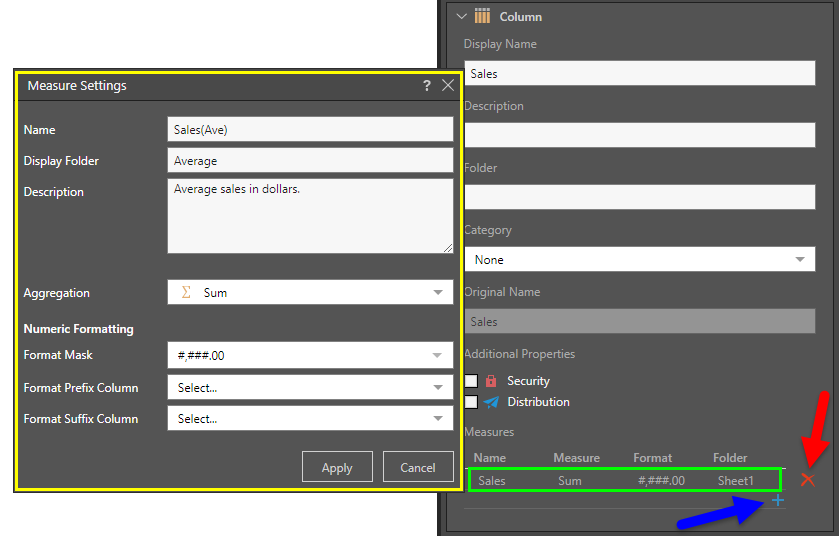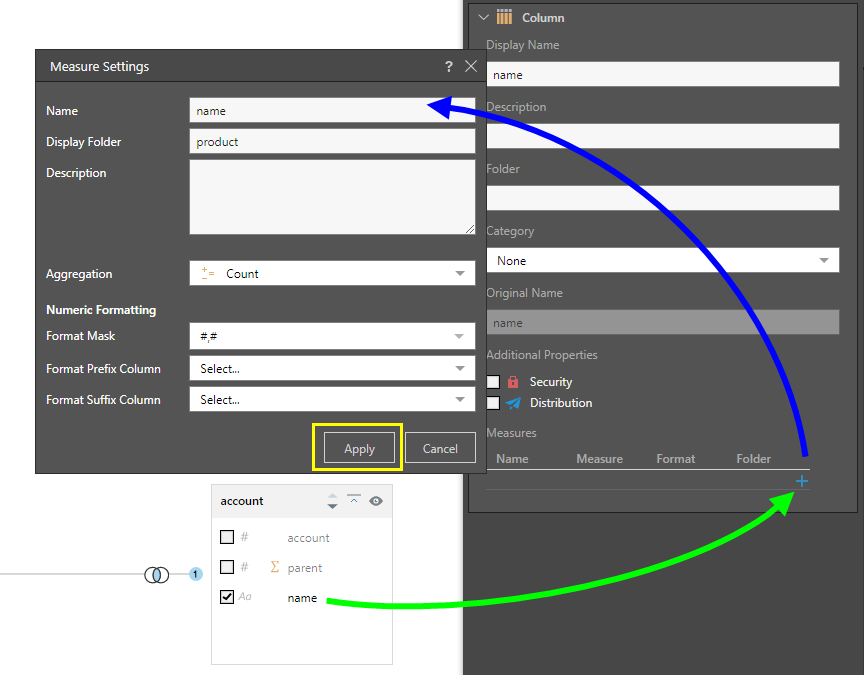From the Measure Editor, you can add new measures to columns and edit existing measures. Pyramid automatically detects numeric decimal columns and assigns a measure to them. Each measure is assigned a default aggregation (Sum) and format (#,###.00). Each measure is also named according to the column with which it is associated. All measures are organized into measure folders that are named according to the table to which the column belongs.
So, there are many changes you may want to make to the measures. You may want to edit existing measures to change the measure name, format, aggregation, or folder. Or you may want to add new measures or delete existing ones.
Measure Properties
Each measure must have the following properties:
- Display Name: this is the name that will be displayed to the end-users once the data model has been processed. By default, the measure is named according to its column, but it can be changed. This is particularly important if the column has multiple measures. You can change the measure's display name without changing the column name from the Measure Editor. If you change the column name from the column context menu, this will also change the measure name accordingly.
- Measure / Aggregation: this is the function by which the column's values will be aggregated. The default aggregation is Sum, but you can change this from the drop-down.
- Format:determines the formatting of the measure. This can be changed by choosing a preset from the list, or entering a custom format.
- Display Folder: this is the name of the folder in which the measure will be stored once the model has been processed.
- Description: (optional) you can add a description to the measure from the Measure Editor; the description will be shown to end-users in a tooltip.
Edit Measures
To open the measure editor, click the required column. Under Measures (red arrow below) in the Properties panel, any existing measures will be listed, along with their metadata (red highlight). Click on a measure to open the Measure Editor (blue highlight), or click the blue plus sign to create a new measure in the Measure Editor.
From the Measure Settings editor, you can edit the following:
- Name
- Aggregation
- Display folder
- Description
- Aggregation
- Format Mask
- Format Prefix Column
- Format Suffix Column
Click Apply to confirm changes. To delete a measure, click its red X.

Add a Measure
There are several reasons you may want to assign a measure aggregation to a column which has not already been defined as a measure. You may have a column that lists values but was not automatically set as a measure column by Pyramid. Or you may have a quantitative (categorical) column for which you also want an measure output. For instance, you may have a Transactions table that contains the column 'Salesperson'. It may be useful to aggregate this column by Count, in order to see the number of transactions performed by each salesperson.
To add a measure to a text column from the Measure Editor, open the column's properties panel and click the blue plus sign (green arrow below) to open the measure editor (blue arrow below). Configure the measure settings and click Apply (yellow highlight below).

- Click here to learn more about measure aggregations.
Multi-Measures
A multi-measure column is a column that has multiple measure aggregations assigned to it. From the Measure Editor, you create multi-measures simply by adding the multiple measures to a single column. In the example below, the Product column has been used to create 4 different measures, each with a different aggregation.
- Click here to learn more about multi-measures.
